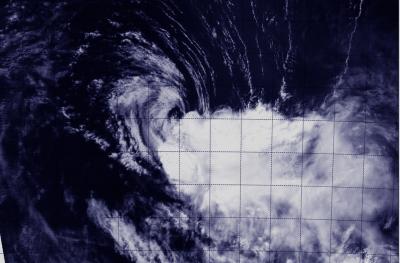NASA satellite sees wind shear whipping Tropical Cyclone Gillian

NASA's Aqua satellite captured this image of Gillian on March 25 at 06:30 UTC/2:30 a.m. EDT, now a tropical storm in the Southern Indian Ocean. Wind shear has pushed clouds and showers away from the center. Credit: NRL/NASA
When NASA's Aqua satellite flew over Gillian on March 25 at 06:30 UTC/2:30 a.m. EDT, the Moderate Resolution Imaging Spectroradiometer or MODIS instrument took a visible picture of the storm.
That image showed that wind shear has pushed clouds and showers away from the center as the storm weakened to a tropical storm.
In the MODIS image, the center of Gillian's circulation is surrounded by some cloudiness, while the bulk of clouds and showers has been pushed to the east-southeast from wind shear from the northwest.
On March 26 at 0900 UTC/5 a.m. EDT, Gillian's maximum sustained winds were near 60 knots. It was centered near 19.6 south latitude and 103.9 east longitude, about 594 nautical miles/683.6 miles/1,100 km west-northwest of Learmonth, Western Australia.
Gillian was moving to the south at 6 knots/6.9 mph/11.1 kph.
The Joint Typhoon Warning Center or JTWC expects Gillian to weaken quickly today as it turns to the southwest in the open waters of the Southern Indian Ocean.
The factors contributing to its rapid weakening include strong wind shear, subsidence or sinking air aloft, and movement into cooler sea surface temperatures.
JTWC forecasters expect Gillian to dissipate by March 26.
Media Contact
More Information:
http://www.nasa.govAll latest news from the category: Earth Sciences
Earth Sciences (also referred to as Geosciences), which deals with basic issues surrounding our planet, plays a vital role in the area of energy and raw materials supply.
Earth Sciences comprises subjects such as geology, geography, geological informatics, paleontology, mineralogy, petrography, crystallography, geophysics, geodesy, glaciology, cartography, photogrammetry, meteorology and seismology, early-warning systems, earthquake research and polar research.
Newest articles

Superradiant atoms could push the boundaries of how precisely time can be measured
Superradiant atoms can help us measure time more precisely than ever. In a new study, researchers from the University of Copenhagen present a new method for measuring the time interval,…

Ion thermoelectric conversion devices for near room temperature
The electrode sheet of the thermoelectric device consists of ionic hydrogel, which is sandwiched between the electrodes to form, and the Prussian blue on the electrode undergoes a redox reaction…

Zap Energy achieves 37-million-degree temperatures in a compact device
New publication reports record electron temperatures for a small-scale, sheared-flow-stabilized Z-pinch fusion device. In the nine decades since humans first produced fusion reactions, only a few fusion technologies have demonstrated…





















